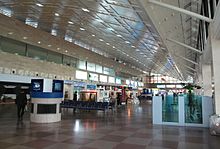Daegu International Airport
Daegu International Airport 대구국제공항 大邱國際空港 Daegu Gukje Gonghang Taegu Kukche Konghang | |||||||||||||||
|---|---|---|---|---|---|---|---|---|---|---|---|---|---|---|---|
 | |||||||||||||||
| Summary | |||||||||||||||
| Airport type | Military/Public | ||||||||||||||
| Operator | Korea Airports Corporation, Republic of Korea Airforce | ||||||||||||||
| Serves | Daegu | ||||||||||||||
| Location | Dong District, Daegu, South Korea | ||||||||||||||
| Elevation AMSL | 116 ft / 35 m | ||||||||||||||
| Coordinates | 35°53′39″N 128°39′32″E / 35.89417°N 128.65889°E | ||||||||||||||
| Website | www | ||||||||||||||
| Map | |||||||||||||||
| Runways | |||||||||||||||
| |||||||||||||||
| Statistics (2013) | |||||||||||||||
| |||||||||||||||
Daegu International Airport (Hangul: 대구국제공항; Hanja: 大邱國際空港; Revised Romanization: Daegu Gukje Gonghang; McCune-Reischauer: Taegu Kukche Konghang) (IATA: TAE, ICAO: RKTN) is the international airport covering southeast region of South Korea. The airfield also is a military base with ROKAF's 11th Fighter Wing based; its three squadrons are flying F-15K.
Overview
The airport chiefly has domestic flights with a small number of international flights. While the airport serves a growing metro area with more than 2.5 million residents, passenger numbers at Daegu airport have been declining since 2004, the year KTX highspeed rail reached Daegu. The 2013 number of about 1.1 million is half the number of passengers that were using the airport before 2003.
History
Taegu Airfield was originally developed during the Japanese Imperial period.
Korean War
At the outbreak of the Korean War the airfield comprised a dirt and gravel runway and two concrete buildings.[3] The airfield was designated by the USAF as K-2.
The airfield was used as part of the Bout One project – an emergency program to train Republic of Korea Air Force pilots to fly the F-51 Mustang fighter. The Bout One planes provided close air support to the U.S. 24th Infantry Division throughout July 1950.[4] The Bout One force was redesignated as the 51st Fighter Squadron (Provisional) on 10 July[5] and merged into the 12th Fighter-Bomber Squadron on 4 August.[6]
The existing dirt and gravel runway was improved by the 822nd Engineer Aviation Battalion commencing on 18 July and the Battalion subsequently prepared a parallel 5,000 feet (1,500 m) PSP runway by 7 August.[7]
USAF units based at Taegu from July–August 1950 included:
- 18th Fighter-Bomber Group, from July–August 1950, subordinate units included:
- 12th Fighter-Bomber Squadron operating F-51 from 15 July 1950[5]
- 51st Fighter Squadron (Provisional) from 10 July-4 August 1950[5]
- 6002nd Air Base Squadron from July-8 August 1950[5]
- 6147th Tactical Control Squadron (Airborne) operating T-6 Mosquitos from 1 August-6 September 1950[8]
- 6149th Air Base Unit from August 1950
Taegu Airfield was abandoned in the face of Korean People's Army assault on Taegu in mid-August 1950, but USAF units began reoccuppying the base on 23 September 1950.[9] The 822nd Battalion had returned to Taegu on 17 September and soon resurfaced the original dirt and gravel runway with PSP and extended its length to 5,700 feet (1,700 m).[10]
USAF units based at Taegu from September 1950 included:[10]
- 49th Fighter-Bomber Group operating F-80s from 1 October 1950. This was the first jet unit to be based in Korea. Subordinate units included:
- 7th Fighter-Bomber Squadron from 28 September
- 8th Fighter-Bomber Squadron from 29 September
- 9th Fighter-Bomber Squadron from 29 September
- 543rd Tactical Support Group from 26 September, subordinate units included:
- 8th Tactical Reconnaissance Squadron, Photo-Jet operating RF-80s from 2 October
- 162nd Tactical Reconnaissance Squadron, Night Photo from 8 October
- 363rd Reconnaissance Technical Squadron from 4 October
In May 1951, the 930th Engineer Aviation Group began rehabilitating the PSP runway and then began building a 9,000 feet (2,700 m) concrete runway.[11]
-
F-84E of the 27th Fighter Escort Group in 1951
-
Casualties being loaded onto a C-54 in 1951
-
An F-86F of the 12th Fighter-Bomber Squadron at Taegu in 1952
Postwar
Passenger facilities

By adopting an arrangement concept symbolizing Ouga (The song of five friends: water, rock, pine tree, bamboo, and moon) by Yun Seon Do and the shape of a flying crane, the terminal has a small but comfortable environment. The parking lot at the airport can accommodate about 1,097 cars and has a fully automatic parking system; it opens from 6 am to 10 pm.[12]
Airlines and destinations
Domestic
| Airlines | Destinations |
|---|---|
| Air Busan | Jeju |
| Asiana Airlines | Jeju |
| Jeju Air | Jeju |
| Korean Air | Jeju, Seoul–Incheon |
| T'way Airlines | Jeju |
International
Access
The airport is 1.34 km from Ayanggyo Station (Daegu Subway Line 1) and can be reached by bus or taxi.
See also
References
- ^ Template:WAD
- ^ Air Traffic by Airport
- ^ Futrell, Frank (1983). The United States Air Force in Korea, 1950–1953. Air Force History & Museums Program. p. 89. ISBN 9780912799711.
- ^ Futrell, p.89-90
- ^ a b c d Futrell, p.95
- ^ Futrell, p.112
- ^ Futrell, p.110
- ^ Futrell, p.106
- ^ Futrell, p.176
- ^ a b Futrell, p.177
- ^ Futrell, p.395
- ^ Information for parking lot
- ^ http://www.routesonline.com/news/38/airlineroute/272980/air-busan-expands-daegu-osaka-service-from-june-2017/
- ^ "Air Busan expands Daegu - Japan service from Dec 2016". routesonline. Retrieved 22 November 2016.
- ^ "Air Busan adds Daegu – Tokyo service from June 2017". routesonline. Retrieved 5 May 2017.
- ^ "Jeju Air adds Daegu – Da Nang route in 1Q17". routesonline. Retrieved 7 December 2016.
{{country data {{{1}}} | air force/core | variant = | size = | name = }}







